
Ulmus americana, generally known as the American elm or, less commonly, as the white elm or water elm, is a species native to eastern North America, naturally occurring from Nova Scotia west to Alberta and Montana, and south to Florida and central Texas. The American elm is an extremely hardy tree that can withstand winter temperatures as low as −42 °C. Trees in areas unaffected by Dutch elm disease can live for several hundred years. A prime example of the species was the Sauble Elm, which grew beside the banks of the Sauble River in Ontario, Canada, to a height of 43 m (140 ft), with a d.b.h of 196 cm (6.43 ft) before succumbing to Dutch elm disease; when it was felled in 1968, a tree-ring count established that it had germinated in 1701.

The Crassulaceae, also known as the stonecrop family or the orpine family, are a diverse family of dicotyledon flowering plants characterized by succulent leaves and a unique form of photosynthesis, known as Crassulacean acid metabolism (CAM). Flowers generally have five floral parts. Crassulaceae are usually herbaceous but there are some subshrubs, and relatively few treelike or aquatic plants. Crassulaceae are a medium size monophyletic family in the core eudicots, among the order Saxifragales, whose diversity has made infrafamilial classification very difficult. The family includes approximately 1,400 species and 34–35 genera, depending on the circumscription of the genus Sedum, and distributed over three subfamilies. Members of the Crassulaceae are found worldwide, but mostly in the Northern Hemisphere and southern Africa, typically in dry and/or cold areas where water may be scarce. although a few are aquatic.

An arboretum in a general sense is a botanical collection composed exclusively of trees. More commonly a modern arboretum is a botanical garden containing living collections of woody plants and is intended at least in part for scientific study.

The San Francisco Botanical Garden at Strybing Arboretum is located in San Francisco's Golden Gate Park. Its 55 acres represents nearly 9,000 different kinds of plants from around the world, with particular focus on Magnolia species, high elevation palms, conifers, and cloud forest species from Central America, South America and Southeast Asia.

Berberis, commonly known as barberry, is a large genus of deciduous and evergreen shrubs from 1–5 m (3.3–16.4 ft) tall, found throughout temperate and subtropical regions of the world. Species diversity is greatest in South America and Asia; Europe, Africa and North America have native species as well. The best-known Berberis species is the European barberry, Berberis vulgaris, which is common in Europe, North Africa, the Middle East, and central Asia, and has been widely introduced in North America. Many of the species have spines on the shoots and along the margins of the leaves.

The Arnold Arboretum of Harvard University is an arboretum located in the Jamaica Plain and Roslindale neighborhoods of Boston, Massachusetts. It was designed by Frederick Law Olmsted and is the second largest "link" in the Emerald Necklace.
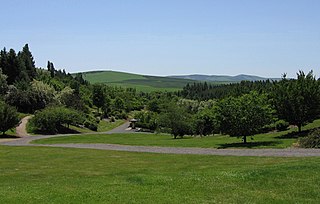
The University of Idaho Arboretum and Botanical Garden is a major arboretum and botanical garden in the northwestern United States, on the campus of the University of Idaho in Moscow, Idaho. Located within a valley south of the President's Residence on Nez Perce Drive and adjacent to the UI Golf Course, its 63 acres (0.25 km2) are open to the public daily without charge.
The Plant Collections Network (PCN) is a group of North American botanical gardens and arboreta that coordinates a continent-wide approach to plant germplasm preservation, and promotes excellence in plant collections management. The program is administered by the American Public Gardens Association from its headquarters in Kennett Square, Pennsylvania in collaboration with the USDA- Agricultural Research Service.

Ulmus davidiana var. japonica, the Japanese elm, is one of the larger and more graceful Asiatic elms, endemic to much of continental northeast Asia and Japan, where it grows in swamp forest on young alluvial soils, although much of this habitat has now been lost to intensive rice cultivation.

Ulmus szechuanicaFang, known as the Szechuan (Sichuan), or red-fruited, elm, is a small to medium deciduous Chinese tree found along the Yangtze river through the provinces of Sichuan, Jiangxi, Anhui, and Jiangsu.

Humulus japonicus, known as wild hop or Japanese hop, synonym H. scandens, is an ornamental plant in the Cannabaceae family. Originally found in temperate parts of Asia and the tropical environment of Vietnam, it was imported to North America in the 1800s for use in an Asian tonic and as an ornamental plant. Since its arrival in North America, it has spread widely. It can be found throughout the Northeastern U.S. and eastern Canada. It is considered an invasive species in North America. The composition and chemistry of its oils differ from those of its relative the common hop, Humulus lupulus. As a result, the Japanese hop is not used in the production of beer.

The Siberian Elm cultivar Ulmus pumila 'Hansen' is a little-known American tree of obscure origin, possibly raised from seed collected by the horticulturist and botanist Prof. Niels Hansen during his expedition to Siberia in 1897.
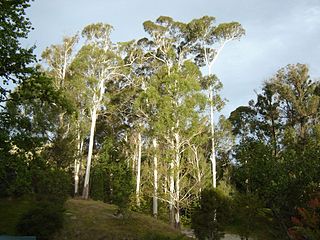
Eastwoodhill is the national arboretum of New Zealand. It covers 131 hectares (1.31 km2) and is located 35 km northwest of Gisborne, in the hill country of Ngatapa. It was founded in 1910 by William Douglas Cook. Cook's life work would become the creation of a giant collection of Northern Hemisphere temperate climate zone trees in New Zealand – a dream that would eventually cost him all his money – buying and importing thousands of trees from New Zealand and British nurseries.

Ulmus parvifolia, commonly known as the Chinese elm or lacebark elm, is a species native to eastern Asia, including China, Taiwan, Japan, North Korea, and Vietnam. It has been described as "one of the most splendid elms, having the poise of a graceful Nothofagus".
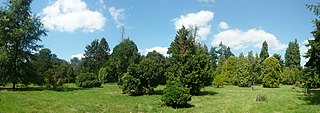
The Arboretum de Versailles-Chèvreloup is a major arboretum located just north of the Palace of Versailles at 30, route de Versailles, Rocquencourt, Yvelines, Île-de-France, France. It forms part of the Muséum national d'histoire naturelle, and is open evryday in the warmer months; an admission fee is charged.
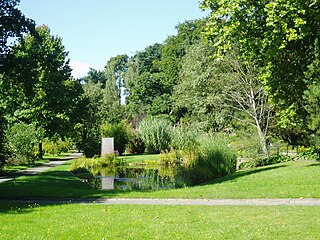
The Botanical Garden in Potsdam, is a botanical garden and arboretum maintained by the University of Potsdam. It has a total area of 8.5 hectares, of which 5 hectares are open to the public, and is located immediately southwest of the Orangery Palace at Maulbeerallee 2, Potsdam, in the German state of Brandenburg. It is open daily; an admission fee is charged for the glasshouses only (2017).

Tallinn Botanic Garden, is a botanical garden in Tallinn, Estonia. It is located on the right bank of the Pirita River, in the Kloostrimetsa forest in Pirita district. With an area of 123 ha, it is the largest in Estonia.
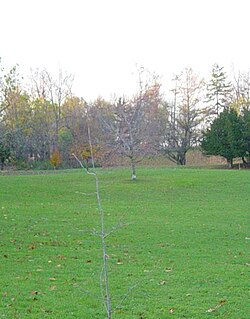
The James Pass Arboretum was established by the City of Syracuse, New York through the philanthropy of Adelaide Salisbury Pass and family with the guidance and cooperation of the State College of Forestry to be a classic arboretum in the tradition of the Arnold Arboretum in Boston MA, that is, a museum of woody plants designed for education and horticultural display.
Carl Ferris Miller (1921–2002), also known by the Korean name Min Byung-gal (민병갈), was an American-born South Korean banker and arborist. Dr CF Miller is the best known as the founder of the Chollipo Arboretum Foundation in Taean-gun, South Chungcheong Province, South Korea, and one of the first Americans to be naturalized as a South Korean citizen.

The Botanic Garden of Casimir the Great University is located in the center of Bydgoszcz, close to the main campus of the Kazimierz Wielki University in Bydgoszcz. The facility fulfils several roles: scientific research, but also didactic and recreational activities.





















